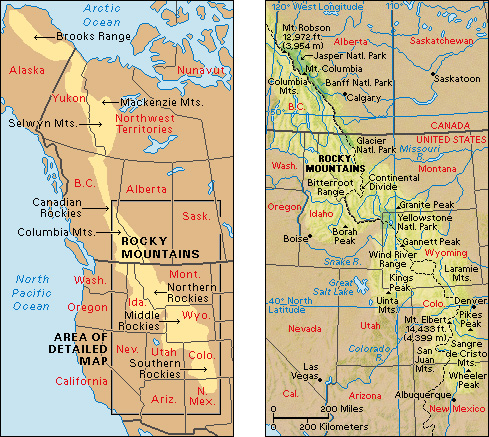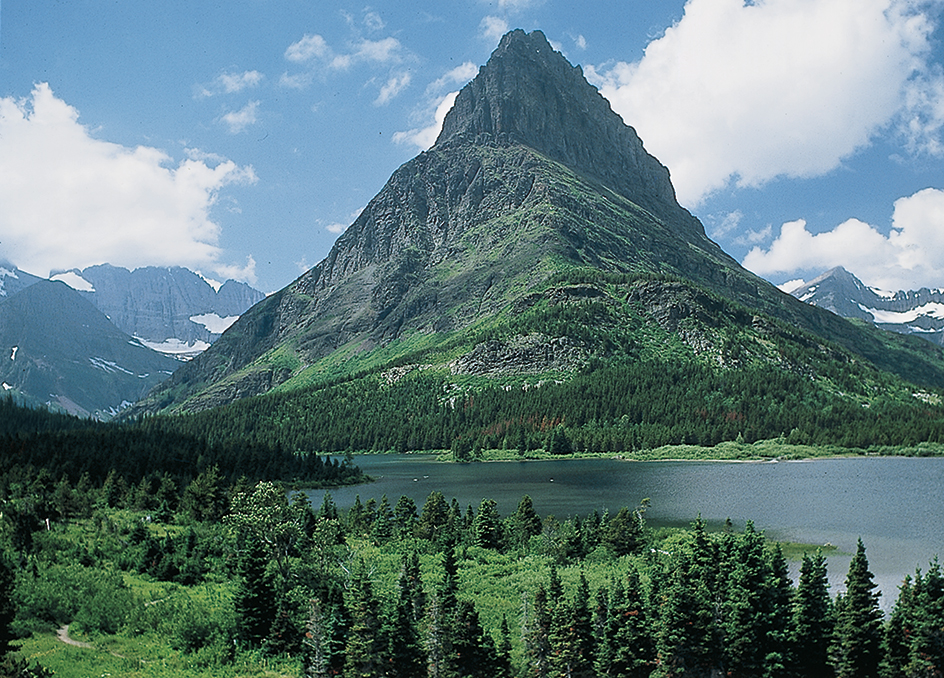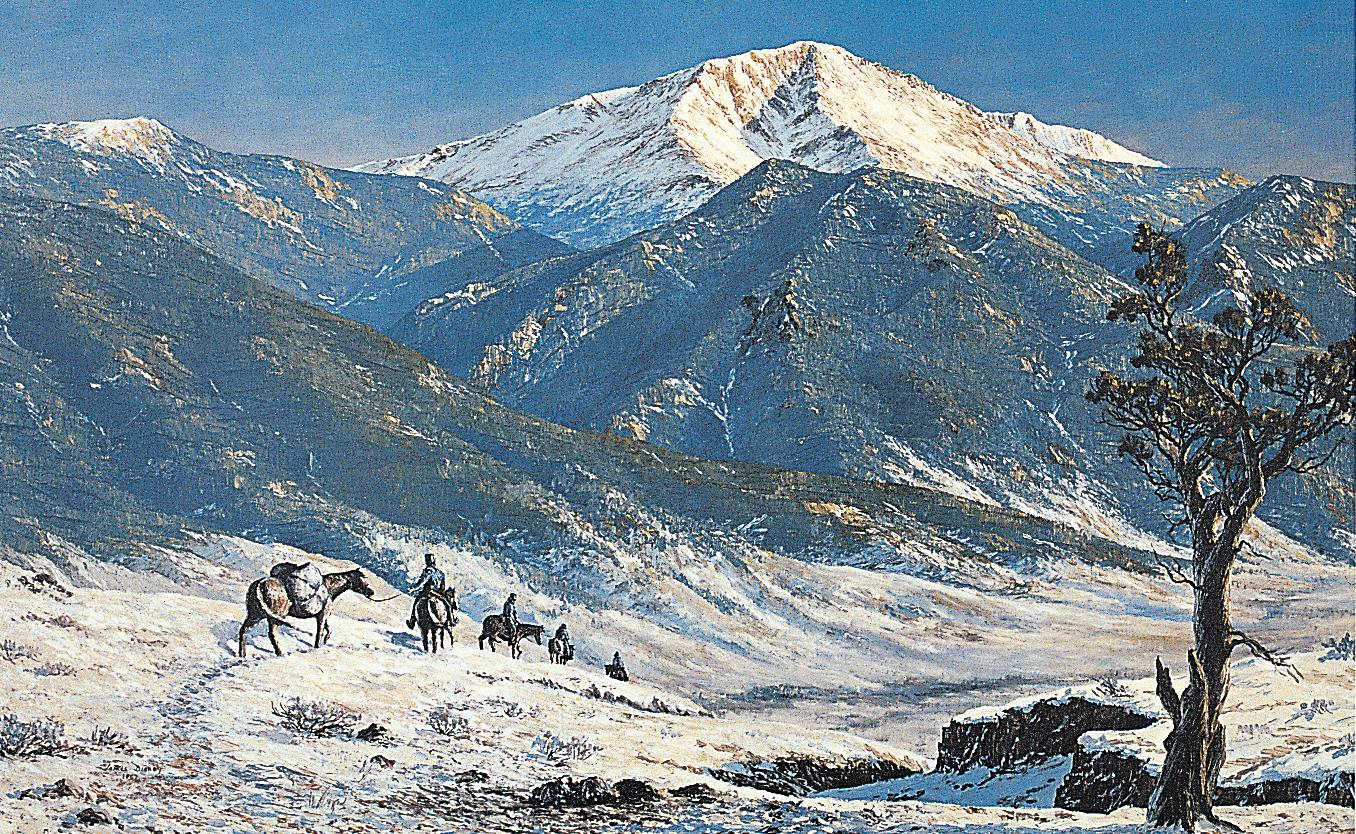Rocky Mountains are the largest mountain system in North America. The Rocky Mountain Chain extends more than 3,000 miles (4,800 kilometers) through the United States and Canada. It is about 350 miles (563 kilometers) wide in some places. In the United States, the Rockies stretch through New Mexico, Colorado, Utah, Wyoming, Idaho, Montana, Washington, and Alaska. The Canadian Rockies spread through the provinces of Alberta and British Columbia, and the Northwest Territories and the territory of Yukon.

Visitors to the Rockies enjoy snow-capped peaks, sparkling lakes, and other magnificent scenery. Several U.S. and Canadian national parks are in the Rocky Mountains. The region is also famous for its ski resorts and wild game.

The Rockies form the Continental Divide, which separates rivers that flow west to the Pacific Ocean from those going east to the Atlantic Ocean (see Divide). The Canadian Rockies also separate rivers flowing north to the Arctic Ocean from those that empty into the Pacific Ocean to the southwest. A number of rivers, including the Arkansas, the Colorado, the Columbia, the Missouri, and the Rio Grande, begin in the Rockies.
Chief ranges of the Rockies
include (1) the Southern Rockies, (2) the Middle Rockies, (3) the Northern Rockies, (4) the Canadian Rockies, (5) the Selwyn and Mackenzie mountains, and (6) the Brooks Range.
The Southern Rockies extend from the Sangre de Cristo Range in New Mexico to central Wyoming. They include the highest peaks in the Rocky Mountain System. Wheeler Peak, the highest peak in New Mexico, is 13,161 feet (4,011 meters) high. Colorado’s tallest peak, Mount Elbert, rises 14,433 feet (4,399 meters). Colorado has about 55 peaks over 14,000 feet (4,267 meters) high.
The Middle Rockies, which include the Grand Tetons, run from northwestern Colorado and northern Utah to the upper Yellowstone River in Montana. The highest peaks in this range include Kings Peak, 13,528 feet (4,123 meters) high, in Utah; Gannett Peak, 13,804 feet (4,207 meters) high, in Wyoming; and Granite Peak, 12,799 feet (3,901 meters) high, in Montana. Yellowstone National Park is in the Middle Rockies.
The Northern Rockies stretch from southern Idaho to the border between the United States and Canada. Borah Peak, the tallest mountain in Idaho, rises 12,662 feet (3,859 meters) in the Northern Rockies. Glacier National Park lies in this region.

The Canadian Rockies extend from the border north through British Columbia and Alberta. Some of the finest scenic areas of the Rockies lie in Alberta, including Banff and Jasper national parks.

The Selwyn Mountains extend beyond the Liard River in northern Canada. The Mackenzie Range lies east of the Selwyns. The Brooks Range crosses northern Alaska. Part of the range lies north of the Arctic Circle.
Plant and animal life.
Forests of pinon pines and junipers cover the lower slopes of the Southern Rockies. Firs, pines, and spruces are abundant in the higher areas of the Rockies. Sagebrush dominates the Wyoming Basin and other valley regions of the Middle Rockies and the Southern Rockies.
Rocky Mountain goats and bighorn sheep live above the timber line, the elevation beyond which trees cannot grow. Bears, deer, hares, elk, minks, mountain lions, porcupines, squirrels, and other animals occupy the higher forested slopes. Chipmunks, coyotes, moose, and muskrats make their homes in the grassy valleys between the mountains. Rainbow trout, grayling, cutthroat trout, and other fishes swim in Rocky Mountain streams.

Agriculture and industry.
Livestock raising is the main agricultural activity in the Rockies. Cattle and sheep are driven to mountain pastures for the summer and back to warmer valleys in winter. Farmers raise chili peppers and pinto beans in the Southern Rockies. Grains, potatoes, sugar beets, and truck vegetables are raised in Colorado, Idaho, Montana, and Utah.
The chief industrial activities of the Rockies are mining and lumbering. The Southern Rockies, especially the Leadville District of Colorado, produce gold, lead, molybdenum, silver, uranium, and zinc. The Wyoming Basin, in southwestern Wyoming, is a coal, petroleum, and natural gas producing area. Lumbering and the mining of coal, copper, lead, silver, and zinc are important in the Northern and Canadian Rockies. Much of the coking coal used in Japan’s iron and steel industry is exported from the Fernie, British Columbia, area.
Tourism contributes greatly to the economy of the Rocky Mountain states and provinces. Every year, millions of visitors enjoy the region’s national parks, ski resorts, and many other attractions.
History.
Most peaks of the Rockies were formed millions of years ago during a great upheaval of Earth’s crust. The sides of the mountains contain fossils of animals that once lived in the sea, and rocks that were formed in the hot interior of Earth. The southern half of the Rockies includes mountains that were once volcanic plateaus. Through the centuries, the peaks of the Rockies have been cut into various formations by the forces of wind, rain, and glaciers.
Many Indian tribes lived along the flanks of the Rockies when Europeans first arrived in North America. They included the Coeur d’Alene, Flathead, Kalispel, Kootenai, Shoshone, and Ute. The first Europeans to reach the Rockies were Spanish explorers. They established a colony near what is now Santa Fe, New Mexico, in 1598.
The American explorers Meriwether Lewis and William Clark traveled through the Northern Rockies in 1805 and 1806. Another American, Zebulon M. Pike, explored the Southern Rockies during this period. Pikes Peak, in central Colorado, was named for him. In the early 1800’s, the Rockies became the center of the American fur trade. See Fur trade (The 1800’s).

The Rockies hampered transportation during the Westward Movement of the 1800’s. However, the Oregon Trail, the longest overland route used by explorers and pioneers, wound through the Rockies (see Oregon Trail). The first railroad route through the Rockies was built in the Wyoming Basin in 1868. Today, Interstate Highway 80 runs through the Wyoming Basin. Major railroad routes also go through the Rockies.
The Eisenhower Memorial Tunnel, west of Denver, Colorado, is the highest motor-traffic tunnel in the world. The tunnel has an altitude of about 11,000 feet (3,400 meters). Moffat Tunnel, one of the longest railroad tunnels in the United States, cuts through James Peak, also west of Denver.
